Various Cultures and Shared Experiences Form Asian American Identities

About six-in-ten feel related to diverse Asians in the U.S.
Pew Analysis Center conducted this diagnosis to realize the prosperous diversity of different folks of Asian foundation or ancestry living in the United States and their views of identification. The study is portion of the Center’s multiyear, comprehensive, in-depth quantitative and qualitative study effort all for the nation’s Asian inhabitants. Its centerpiece is that this nationally representative seek for of 7,006 Asian adults exploring the experiences, attitudes and views of Asians living in the U.S. The quest for sampled U.S. adults who self-title as Asian, both by myself or in combination with diverse races or Hispanic ethnicity. It used to be provided in six languages: Chinese (Simplified and Stale), English, Hindi, Korean, Tagalog and Vietnamese. Responses had been restful from July 5, 2022, to Jan. 27, 2023, by Westat on behalf of Pew Analysis Center.
The Center recruited an amazing pattern to head looking out for the range of the U.S. Asian inhabitants, with oversamples of the Chinese, Filipino, Indian, Korean and Vietnamese populations. These are the 5 largest foundation groups amongst Asian American citizens. The quest for also entails an amazing sufficient pattern of self-identified Japanese adults, making findings about them reportable. On this myth, the six largest ethnic groups consist of different folks that title with one Asian ethnicity solely, both by myself or in combination with a non-Asian hobble or ethnicity. Collectively, these six groups constitute 81% of all U.S. Asian adults, according to a Pew Analysis Center diagnosis of the Census Bureau’s 2021 American Community Watch (ACS), and are the six groups whose attitudes and opinions are highlighted at some point of the myth. Watch respondents had been drawn from a nationwide pattern of residential mailing addresses, which integrated addresses from all 50 states and the District of Columbia. Specialised surnames list frames maintained by the Marketing Programs Team had been broken-down to complement the pattern. These eligible to complete the quest for had been provided the change to beget so on-line or by mail with a paper questionnaire. For more particulars, peek the Methodology. For questions broken-down on this diagnosis, peek the Topline Questionnaire.
The quest for study thought and questionnaire had been reviewed and authorized by Westat’s institutional overview board (IRB), which is an external and honest committee of consultants specializing in defending the rights of study participants.
Even if the U.S. Asian inhabitants used to be the fastest rising racial and ethnic crew in the nation from 2000 to 2019, it’s far peaceful an attractive diminutive inhabitants. Constant with the 2021 American Community Watch, the nation’s Asian inhabitants constitutes 7% of the U.S. inhabitants (of all ages) and 7% of adults (these ages 18 and older).
Pew Analysis Center designed this study with these particulars in mind to be as inclusive as doable of the range of Asian American experiences. Even so, seek for study is proscribed when it comes to documenting the views and attitudes of the much less populous Asian foundation groups in the U.S. To tackle this, the quest for used to be complemented by 66 pre-seek for point of interest groups of Asian adults, conducted from Aug. 4 to Oct. 14, 2021, with 264 recruited participants from 18 Asian foundation groups. Center of attention crew discussions had been conducted in 18 diverse languages and moderated by participants of their foundation groups.
Findings for much less populous Asian foundation groups in the U.S., other folks which could perchance be no longer amongst the six largest Asian foundation groups, are grouped under the class “Utterly different” on this myth and are integrated in the general Asian grownup findings in the myth. These ethnic foundation groups every make up about 2% or much less of the Asian inhabitants in the U.S., making it bright to recruit nationally representative samples for every foundation crew. The crew “Utterly different” entails other folks that title with one Asian ethnicity solely, both by myself or in combination with a non-Asian hobble or Hispanic ethnicity. Findings for folks that title with two or more Asian ethnicities will no longer be provided by themselves on this myth however are integrated in the general Asian grownup findings.
To learn more about how participants of much less populous Asian foundation groups in the U.S. title, peek the quote sorter in accordance with our point of interest crew discussions. There, you can perchance per chance learn how participants list their identification in their bask in phrases.
For this diagnosis, a further nationwide seek for of 5,132 U.S. adults used to be conducted from Dec. 5 to 11, 2022, the use of Pew Analysis Center’s American Traits Panel. The quest for of U.S. adults used to be conducted in English and Spanish. Respondents are recruited through nationwide, random sampling of residential addresses.
Pew Analysis Center has conducted more than one experiences that target Asian American citizens. Earlier demographic experiences examined the diversity of origins, key details, and rising earnings inequality amongst Asians living in the U.S. and key findings about U.S. immigrants. Qualitative experiences beget all for what it technique to be Asian in The usa as effectively as barriers to English language studying amongst Asian immigrants. Earlier surveys beget all for considerations over discrimination and violence in opposition to Asian American citizens, as effectively as experiences about their non secular beliefs. Receive these publications and more on the Center’s Asian American citizens topic page.
Pew Analysis Center is a subsidiary of The Pew Charitable Trusts, its foremost funder. The Center’s Asian American portfolio used to be funded by The Pew Charitable Trusts, with generous toughen from The Asian American Foundation; Chan Zuckerberg Initiative DAF, an informed fund of the Silicon Valley Community Foundation; the Robert Wood Johnson Foundation; the Henry Luce Foundation; the Doris Duke Foundation; The Wallace H. Coulter Foundation; The Dirk and Charlene Kabcenell Foundation; The Long Family Foundation; Lu-Hebert Fund; Gee Family Foundation; Joseph Cotchett; the Julian Abdey and Sabrina Moyle Charitable Fund; and Nanci Nishimura.
We would also want to thank the Leaders Discussion board for its belief leadership and precious help in helping make this seek for doable.
The strategic communications marketing and marketing campaign broken-down to promote the study used to be made doable with generous toughen from the Doris Duke Foundation.
The terms Asian, Asians living in the United States, U.S. Asian inhabitants and Asian American citizens are broken-down interchangeably at some point of this myth to consult with U.S. adults who self-title as Asian, both by myself or in combination with diverse races or Hispanic identification.
Ethnicity and ethnic foundation labels, equivalent to Chinese and Chinese foundation, are broken-down interchangeably on this myth for findings for ethnic foundation groups, equivalent to Chinese, Filipino, Indian, Japanese, Korean or Vietnamese. For this myth, ethnicity is no longer nationality. As an instance, Chinese on this myth are these self-figuring out as of Chinese ethnicity, reasonably than essentially being a contemporary or broken-down citizen of the Other folks’s Republic of China. Ethnic foundation groups on this myth consist of different folks that self-title as one Asian ethnicity solely, both by myself or in combination with a non-Asian hobble or ethnicity.
Less populous Asian foundation groups on this myth are other folks that self-title with ethnic foundation groups which could perchance be no longer amongst the six largest Asian foundation groups. The time frame entails other folks that title with solely one Asian ethnicity. These ethnic foundation groups every picture about 2% or much less of the general Asian inhabitants in the U.S. As an instance, other folks that title as Burmese, Hmong or Pakistani are integrated on this class. These groups are unreportable on their bask in as a consequence of diminutive pattern sizes, however collectively they’re reportable under this class.
The terms Asian origins and Asian foundation groups are broken-down interchangeably at some point of this myth to list ethnic foundation groups.
Immigrants on this myth are other folks that weren’t U.S. electorate at beginning – in diverse phrases, these born originate air the U.S., Puerto Rico or diverse U.S. territories to other folks who will no longer be U.S. electorate. Immigrant, first technology and international born are broken-down interchangeably to consult with this crew.
Naturalized electorate are immigrants who are factual permanent residents who beget fulfilled the size of preserve and quite plenty of requirements to become U.S. electorate and who beget taken the oath of citizenship.
U.S. born refers to other folks born in the 50 U.S. states or the District of Columbia, Puerto Rico or diverse U.S. territories.
Second technology refers to other folks born in the 50 states or the District of Columbia, Puerto Rico or diverse U.S. territories with a minimal of 1 first-technology (immigrant) parent.
Third or elevated technology refers to other folks born in the 50 states or the District of Columbia, Puerto Rico or diverse U.S. territories with both other folks born in the 50 states, D.C., Puerto Rico or diverse U.S. territories.
The nation’s Asian inhabitants is rapid rising and various. Numbering more than 23 million, the inhabitants has ancestral roots across the rotund, ethnically and culturally prosperous Asian continent. For Asians living in the United States, this diversity is mirrored in how they list their bask in identification. Constant with a brand unusual, nationwide, comprehensive seek for of Asian adults living in the U.S., 52% explain they most assuredly use ethnic labels that reproduction their heritage and household roots, both by myself or along with “American,” to list themselves. Chinese or Chinese American, Filipino or Filipino American, and Indian or Indian American are examples of these adaptations.
There are diverse programs at some point of which Asians living in the U.S. list their identification. About half of (51%) of Asian adults explain they use American on its bask in (10%), along with their ethnicity (25%) or along with “Asian” as Asian American (16%) when describing their identification, highlighting their hyperlinks to the U.S.
And whereas pan-ethnic labels equivalent to Asian and Asian American are steadily broken-down to list this various inhabitants broadly, the unusual seek for displays that after describing themselves, factual 28% use the tag Asian (12%) on its bask in or the tag Asian American (16%).
The quest for also finds that diverse labels are broken-down by Asian American citizens. Some 6% explain they most assuredly want regional terms equivalent to South Asian and Southeast Asian when describing themselves.
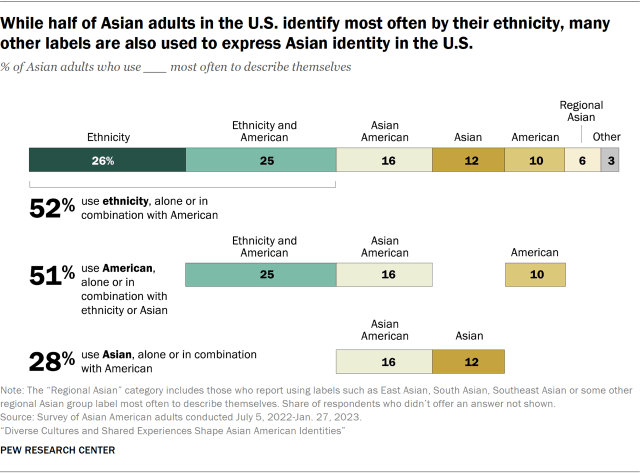
Asian adults peek more cultural differences than commonalities across their crew as effectively. When requested to determine from two statements – that Asians in the U.S. share a frequent tradition, or that Asians in the U.S. beget many change cultures – unbiased about all (90%) explain U.S. Asians beget many change cultures. Real 9% explain Asians living in the U.S. share a frequent tradition. This seek is widely held across many demographic groups amongst Asian American citizens, according to the quest for.
The seek that Asian American citizens beget many change cultures could be one held by the favorite public, according to one other Pew Analysis Center seek for of U.S. adults, conducted in December 2022. Among all U.S. adults, 80% explain Asians in the U.S. beget many change cultures, whereas 18% explain they share a frequent tradition.1
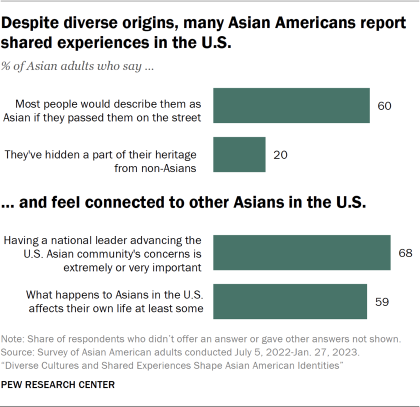
Although Asian American citizens’ identities replicate their various cultures and origins, Asian adults also myth obvious shared experiences. A majority (60%) explain most other folks would list them as “Asian” whereas walking past them in the road, indicating most Asian adults feel they’re considered by others as a single crew, despite the inhabitants’s diversity. One-in-5 explain they’ve hidden a portion of their heritage (their ethnic food, cultural practices, ethnic clothing or non secular practices) from others who will no longer be Asian, in some cases out of fright of embarrassment or discrimination. Severely, Asian adults ages 18 to 29 assuredly tend to explain they’ve performed this than Asians 65 and older (39% vs. 5%).
Asian adults in the U.S. also feel related with diverse Asian American citizens. About six-in-ten (59%) explain that what happens to Asians in the U.S. affects their bask in lives, a minimal of to a pair degree.2 And about two-thirds (68%) of Asian American citizens explain this could perchance be very or wanted to beget a nationwide chief advocating for the considerations and wants of the Asian inhabitants in the U.S.
The unusual seek for also displays that incredible majorities of Asian adults share related views on what it takes to be even handed essentially American. And so that they supply belief to a lot of the identical factors to be significant in their views of the American dream.
These are amongst essentially the most significant findings from Pew Analysis Center’s unusual seek for of Asian American adults, conducted by mail and on-line from July 5, 2022, to Jan. 27, 2023. Here’s essentially the most bright nationally representative seek for of its kind to this point that all for Asian American citizens. The quest for used to be conducted in English and 5 Asian languages, amongst a representative pattern of 7,006 Asian adults living in the United States.
Asian American citizens are 7% of the U.S. inhabitants, according to a Pew Analysis Center diagnosis of the 2021 American Community Watch. Their inhabitants is various, with roots in extra than 20 worldwide locations in East Asia, Southeast Asia and the Indian subcontinent. About 54% of the nationwide Asian inhabitants are immigrants. The six largest foundation groups (Chinese, Filipino, Indian, Japanese, Korean and Vietnamese), a degree of interest of this seek for and myth, together tale for seventy 9% of all Asian American citizens.
Overall, about 34% of Asian American citizens are the U.S.-born younger other folks of immigrant other folks, and one other 14% are of third or elevated technology (that design their other folks had been born in the U.S. as effectively), according to a Pew Analysis Center diagnosis of the 2022 Fresh Inhabitants Watch, March Annual Social and Economic Supplement.
This seek for and myth point of interest on Asian adults in the U.S. The six largest foundation groups together tale for 81% of Asian adults. And 68% of Asian American adults are immigrants, according to Center diagnosis of the 2021 American Community Watch. Moreover, 25% are the U.S.-born younger other folks of immigrant other folks and 10% are of third or elevated technology, according to Center diagnosis of govt data.
The making of Asian American identification and data of Asian history in the U.S.
The pan-ethnic time frame “Asian American” emerged in Berkeley, California, in the 1960s as portion of a political motion to put together the change U.S. Asian inhabitants. The introduction of an Asian American identification used to be in reaction to a prolonged history of exclusion of Asians in the nation, including the 1882 Chinese Exclusion Act and a pair of Supreme Complaints in the 1920s clarifying that Asians, including South Asians, will no longer be “free White other folks” and subsequently had been excluded from changing into naturalized U.S. electorate.3 Subsequently, the time frame used to be adopted by the federal govt and on the present time is the main identification tag broken-down by media, lecturers, researchers and others to list on the present time’s various Asian American inhabitants.
Most frequently on the present time, somebody is even handed Asian or Asian American if they self-title as such. But Asian American citizens beget no longer essentially agree on which regional or ethnic groups from the Asian continent they supply belief to to be Asian, according to the unusual seek for. The rotund majority of Asian adults explain they supply belief to those from East Asia, equivalent to Chinese or Koreans (89%); Southeast Asia, equivalent to Vietnamese or Filipinos (88%); and to a lesser extent South Asia equivalent to Indians or Pakistanis (67%) to be Asian.
But Asian adults are split on whether they supply belief to Central Asians equivalent to Afghans or Kazakhs to be Asian (43% of Asian adults explain they’re). Whereas about half of of Indian adults (56%) explain they’d consist of Central Asians in the class Asian, fewer than half of of Filipino (40%), Chinese (39%), Japanese (34%), Korean (32%) and Vietnamese (30%) adults take into tale them Asian.
Few Asians explain they’re an authority about U.S. Asian history
Asian American citizens beget a prolonged history in the United States. From Chinese laborers who helped regain the predominant transcontinental railroad, to Japanese immigrants who arrived as plantation workers in what is now the notify of Hawaii, to the incarceration of Japanese American citizens at some point of World Battle II, to Filipinos being treated as U.S. nationals whereas the Philippines used to be a U.S. territory, the Asian American ride has been a portion of U.S. history.
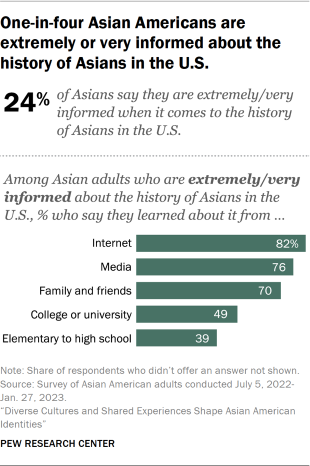
With the passage of the landmark Immigration and Nationality Act of 1965, a brand unusual wave of immigrants from Asia began arriving in the United States, organising a brand unusual, contemporary U.S. Asian history. The Vietnam Battle and quite plenty of conflicts in Southeast Asia brought Vietnamese and quite plenty of Southeast Asian refugees to the U.S., first with the passage of the 1975 Indochina Migration and Refugee Help Act after which with the Refugee Act of 1980. The 1990 Immigration Act raised immigration ceilings and station in position processes that allowed the flows of Asian immigrants, critically of high-expert immigrants, to proceed and extend. The U.S. technology enhance of the Nineties and 2000s attracted many high-expert immigrants, critically from India and China, to tech products and companies around the nation.
This prosperous history, nonetheless, is diminutive-known to Asian adults, according to the unusual seek for. One-in-four (24%) explain they’re very or extremely informed about history of Asians in the United States, whereas an equal share (24%) explain they’re diminutive or in no arrangement informed.
The bulk of these very or extremely informed regarding the history of Asians in the U.S. explain they realized about this history through informal channels: recordsdata superhighway (82%), media (76%) and household and chums (70%). In distinction, 49% realized about it from college or college lessons and 39% from classic through high college.
Immigrant ties shape Asian American citizens’ identities and their life in the U.S.
Immigration experiences, connections with dwelling worldwide locations, and the arrangement in which prolonged somebody has lived in the U.S. shape many Asian American citizens’ identities. Among Asian adults in the U.S., immigrants are more doubtless than other folks which could perchance be U.S. born to list their identification most assuredly with their ethnic labels, both by myself or along with the tag American (56% vs. 41%).
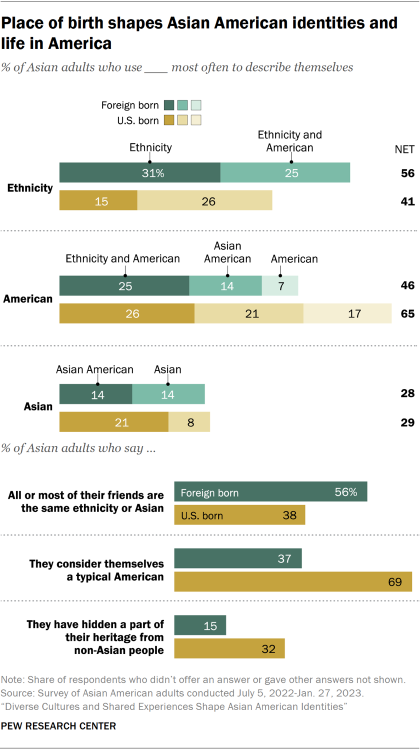
In the intervening time, Asian immigrants are much less doubtless than U.S.-born Asians (46% vs. 65%) to explain they most assuredly list themselves as American indirectly – whether by their ethnic tag combined with American, as Asian American, or simply as American. Peaceable, unbiased about half of of Asian immigrants list themselves in such a three programs.
When it involves figuring out with the tag Asian – both by myself or as Asian American – immigrant and U.S.-born Asians are about equally doubtless to explain they beget so (28% and 29% respectively). Immigrant Asians are much less doubtless than U.S.-born Asians to title most assuredly as Asian American (14% vs. 21%).
On the quiz of seeing themselves more as a “odd American” or “very diverse from a odd American,” Asian immigrant adults are far much less doubtless than these born in the U.S. to take into tale themselves as a odd American (37% vs. 69%).
Nativity could be tied to how Asians in the U.S. beget their friendships. These that immigrated to the U.S. assuredly tend to beget chums who are Asian or of the identical ethnicity as them than are U.S.-born Asians (56% vs. 38%).
Asian immigrants (15%) are also much less doubtless than U.S.-born Asians (32%) to beget ever hidden a portion of their heritage from other folks which could perchance be no longer Asian. When requested in an originate-ended quiz to show cover why they cover parts of their tradition, some U.S.-born respondents mentioned phrases equivalent to “fright of discrimination,” “being teased” and “embarrassing.”
Views of identification amongst Asian American immigrants are assuredly tied to time spent in the U.S.
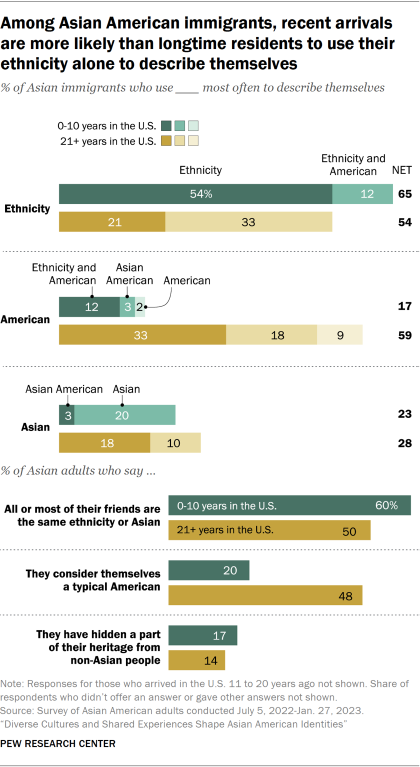
How prolonged Asian immigrants beget lived in the U.S. also shapes their identification and experiences. These that arrived in the U.S. in the past 10 years are more doubtless than other folks that arrived more than two decades in the past to explain they most assuredly use their ethnicity, equivalent to Filipino or Vietnamese, to list themselves. And about two-thirds (65%) of different folks that arrived in the U.S. in the past decade list their identification most assuredly with their ethnicity’s name, both by myself or combined with American, compared with 54% amongst other folks which had been in the nation for more than two a protracted time.
Roughly half of (54%) of different folks which beget arrived in the past 10 years explain they most assuredly use solely their ethnicity to list themselves, compared with factual 21% of different folks that arrived more than two a protracted time in the past who explain the identical.
On the assorted hand, factual 17% of Asian immigrants who arrived in the nation in the past 10 years list themselves most assuredly as American, by their ethnic tag combined with American, or as Asian American, whereas 59% of different folks that arrived more than two decades in the past beget so.
When it involves their circle of chums, 60% of Asian immigrants who arrived in the past 10 years explain most or all of their chums are also Asian American citizens, whereas 50% of different folks that arrived more than two decades in the past explain the identical.
And when requested if they rep themselves as odd American citizens or no longer, Asian immigrants who arrived in the U.S. in the past decade are substantially much less doubtless than other folks that arrived more than two a protracted time in the past to explain they’re odd American citizens (20% vs. Forty eight%).
The unusual seek for also explored the views Asian American citizens beget about traits that make one “essentially American.” Overall, Asian American citizens and the favorite U.S. inhabitants share related views of what it technique to be American. Almost all Asian adults and U.S. adults explain that accepting other folks of various racial and religious backgrounds (94% and 91%), believing in individual freedoms (92% and 94%) and respecting U.S. political institutions and authorized guidelines (89% and 87%) are significant for being essentially American.
Equally, Asian American citizens and the U.S. favorite inhabitants share in their views regarding the American dream. They are saying having freedom of desire in how one can are living one’s life (96% and 97% respectively), having a factual household life (96% and 94%), retiring with ease (96% and 94%) and proudly owning a dwelling (both 86%) are significant to their seek of the American dream. Smaller shares of Asian and U.S. adults (30% and 27%) explain proudly owning a change is required to their seek of the American dream.
Here are diverse seek for findings highlighting the change views and attitudes of Asian adults living in the U.S.:
- Indian adults are the in all likelihood of the six largest Asian foundation groups to explain they most assuredly use their ethnicity, with out the addition of “American,” to list themselves. About four-in-ten Indian adults (41%) explain they beget this. By comparison, smaller shares of Korean (30%), Filipino (29%), Chinese (26%) and Vietnamese (23%) adults beget the identical. Japanese adults (14%) are the least doubtless amongst essentially the most bright groups to make use of their ethnic identification time frame by myself.
- Japanese adults are the least doubtless amongst essentially the most bright Asian foundation groups to explain they’ve friendships with diverse Asians. About one-in-three Japanese adults (34%) explain most or all their chums share their bask in ethnicity or are otherwise Asian. By distinction, about half of of all Indian (55%), Vietnamese (55%), Chinese (51%), Korean (50%) and Filipino (Forty eight%) respondents explain the identical.
- One-in-four Korean adults (25%) explain they’ve hidden portion of their heritage from other folks which could perchance be no longer Asian. Some 20% of Indian, 19% of Chinese, 18% of Vietnamese, 16% of Filipino and 14% of Japanese adults explain they’ve performed the identical.
- All over essentially the most bright ethnic groups, about half of or more explain that what happens to Asians in the U.S. affects what happens in their bask in lives. About two-thirds of Korean (67%) and Chinese (65%) adults explain this. By comparison, 61% of Japanese, 54% of Filipino, 55% of Indian and 52% of Vietnamese adults explain they’re impacted by what happens to Asians nationally.
- Most Asian adults amongst essentially the most bright ethnic foundation groups explain a nationwide chief advancing the U.S. Asian community’s considerations is required. Roughly three-in-four Filipino (74%) and Chinese (73%) adults explain it’s far extremely or extremely significant to for the U.S. Asian community to beget a nationwide chief advancing its considerations. A majority of Vietnamese (69%), Korean (66%), Japanese (63%) and Indian adults (62%) says the identical.
- About half of of Vietnamese registered voters (51%) title with or lean to the Republican Occasion. In distinction, about two-thirds of Indian (68%), Filipino (68%) and Korean (67%) registered voters title with or lean toward the Democratic Occasion. And 56% of Chinese registered voters also partner with the Democratic Occasion.